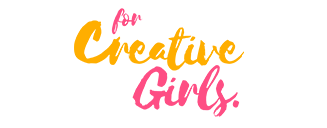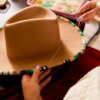Nicolle Herrera is a graphic designer from Colombia, who works with illustration, branding, photography and motion graphics. She has worked as a 2D artist for videogames (character design and concept art); on illustrations for charity projects; motion graphics for brand advertisement. Also as a freelancer, she has worked in fashion photography and branding, as well as curating graphics for startups and for web use. She also spends quality time working on personal projects of life stories and humorous content. Let’s meet her!
Hi Nicolle, it’s really nice to meet you. Looking through your works, I see how awesome and unique they are. I read your bio and saw that your parents are art dealers. Am I correct?
Yes.
So, I am curious, what was it like as a designer growing up with so much creativity around?
Well, it was really an advantage because in my country, Colombia, and I guess in some other countries as well, the creative industry is really undervalued. So, for example, when you say to your parents, oh, I want to go into design or anything related to the creative industry, they will most times tell you not to and ask what you can do with such a degree? So, it’s extremely undervalued. They could go further to say ‘okay, so you’re going to be an artist. How are you going to live? How are you going to earn money and how are you going to help yourself?’ It’s really difficult. However, in my case, because my parents have always been related to the art industry, but as art dealers, they have an eye for art. So, when I told them at first that I wanted to study something related to this, they said to go ahead. Of course, they said like, do you want to study maybe for the police or the Marines or for medicine? And I was like, ‘No, I can’t really see myself as a Marine’, although I did think about it for a while, later concluded that I’m not made for that. And of course, considering the training behind it and so on, I was like, they will be a waste of time and money because I know that that’s not the path that I want to follow. So, when I told them that I wanted to study design, they were like, ‘well, go ahead, if that’s what you want.’ So that was a plus for me because they know that the creative industry is huge and that you can add value to society or add value to your projects and so on through your expression. That’s more or less how I got into it and it was pretty cool growing up. Being a child, the access to people and different galleries, going around and seeing how my parents were into that medium, that was pretty interesting. And I really enjoyed it when I was in school. I really enjoy the arts and culture versus those that had to do with, of course, mathematics and the similar ones, but I had a keen interest in art. So, the way we grew up is actually different. Even my siblings, for example, are studying things related to the creative industries, and we really like it.
Oh, wow that’s such a beautiful story. So, you studied in what college?
Universidad Piloto de Colombia. Still studying actually, and almost graduating. I also have different specialisations apart from art.
Okay, you mean apart from art and design, you have other specialisations in college?
Yes. I am into, for example, animation, various kinds of animations, there’s also role character design, etc. And photography – fashion photography to be specific.
Wow, now I see the link. Like I said earlier about your bio, I saw that you had worked with fashion start-ups. So, I think I see the link between that and the fashion photography you just mentioned. Am I right?
Yes. I will consider myself versatile, even though I am in graphic design, I don’t like to stay in one sphere. For example, not just graphic design, but more multidisciplinary design. So, there are several parts as well and I’m planning to expand into, for example, technology, which is a part of AI. And then planning on VR and then expanding it more and more into the metaverse because I have a keen interest in that.
Oh, web 3 technology you mean?
Exactly.
Awesome! Speaking of technology, I’ve read articles that said a lot of graphic designers are switching to user experience design and user interface design. What do you think about that? Do you think it’s good that a lot of graphic designers are pivoting into that or it’s just, I don’t know, maybe just a claim or something? I mean, you’re in the graphic design industry, so you would know better, so tell us.
Well, I think it’s good. Because in between, for example, graphic design, there are a lot of possibilities. You can go into branding and you may be into typography. So those are two different angles you can approach it from. In my case, even though of course I can do a lot of that, I’m more into world-building visuals for Fun, visuals for empowerment, that offer valuable things to the society. But to the question possibilities create more optimism and, in my case, I went into product photography and I still want to, of course, expand my abilities and start mixing things up. Also, work on reinforcing my knowledge of the visual language. And I get that more people have of course started learning from other things including interface design, etc. Although I haven’t gotten that deep into that, in the creative industry you have to keep on renovating yourself, if not you stay behind others. So yes, it is good.
So you think it’s a good move as a designer to keep up with the evolving technologies?
Exactly and the necessities of the market demand it. If for example people need more of a certain skill, then, they can look up to you if you have an extra ability than others that gives you a plus above the rest
Yes, I do agree with you. Considering the fast-paced evolution of technology, it’s important to keep up, so you’re not left in the backseat of what’s happening. However, looking at this need, do you think that there’s a possibility for creatives or designers to burn out or like to lose their ‘it factor’ that is what makes them unique?
Maybe not all of them, but I think many because, one thing is what you’re passionate about, and another is what you studied. Same for any part of the creative industry whether in music, as an actor, actress, or into the different branches of design, etc. There’s also the necessity to be employed, to earn money, or to survive as a motivator, which of course, depends on the country though. On the other hand, some people are constantly seeking more ways to provide more value to the creative industry, although not all. For me, the former are the designers I believe to be most effective. Despite this view, I would encourage having passion projects alongside the race to keep up, which are more like for yourself which you may or may not monetize. While doing this, it’s also good to consider how you are going to level up or what other types of income you will receive. So, it’s a really difficult journey. For example, when you’re a freelancer, it’s even harder. And when you are in a company that depends heavily on your skills, of course, your hands will be a little bit tight, because it’s what the company wants you to do which sometimes means taking low risks and having little creative freedom. So, there are so many situations that can influence a designer’s decision.
So, if I get you right, you’re saying designers having their own passion projects while working through the dynamics of balancing can also be a means to preserve their uniqueness,
Exactly. If there are no passion projects, whether you win, or lose, you might fail to find your language, in this case, visual communication. So that’s why there’s a lot of seeing a lot of generic or repetitive despite the myriads of talent out there. But what you see is only about trends. Not just in topics but in visuals. So, I’ve seen many designs similar to each other and it’s difficult to differentiate them.
So, there are just so many similarities, and everybody looks like everybody?
Yes, although people are super talented, there’s something that’s missing, something more than just following today’s trends.
Speaking of trends and design style, when I look at your design, I see an undertone of storytelling. I would like to know how you managed to use storytelling to make your design?
Yes, the part of storytelling is quite a great tool, a great method to convey things in my case because I work with a world-building initiative, which is a creation of worlds. And actually, those two are linked to each other because when you think about storytelling you think about a plan. You think about characters, in this case, there are characters of course, so, in my case there I deal with a part of character design. They all lead up to the use of storytelling, specifically, optimistic storytelling because as a person even though I can be negative many times in my work, I don’t like to portray those feelings because I think there’s so much negativity in the world like violence, etc. I choose instead to approach topics from a side of optimism. And I tend to avoid those elements that are controversial. That’s not getting to conflict of course, because for example, things like religion, or things like politics, those sensitive topics, are grounds I don’t like to approach because they really lead to conflict. So, I’m not really into that. But yes, highlighting optimistic elements, as a part of storytelling as I said about the creation of worlds, helps in character creation. The creation of stories is plotted, even if it’s a static image, which could be written for example, in photography or illustration, and animation. Of course, it works even better because you have more frames `which of course requires more elements to it because it’s a moving image that has timing and sound. That’s where I come into collaboration with other people, for example, I don’t manage it all, especially when it has to do with sound and I don’t compose new pieces and things like that. So that’s when I like collaborating with others that can help with achieving that storytelling part of the design
Okay, let me just take you a little bit back to what you said earlier about social issues like politics and all of that. Are there any social issues that you’re passionate about that you would like to express through your art?
That’s a good question. It’s directly related to me being a, you could say, co-partner of an initiative which we are planning on launching soon. I think that’s what I’m mostly focused on, apart from all different things and so on. I think one of the main issues that we’re touching on, which is the undervaluation in creative industries which I highlighted earlier, is that it hasn’t been resolved. It’s a topic that goes around the world, maybe in some places a little bit higher, and in others less. It’s something that even the United Nations hasn’t been able to address properly or find a solution to. It goes beyond just being paid, that is the creative economy, but to the need for recognition. Because of course, this industry provides value, so it’s not only about common careers termed as highly paid, for instance, medicine or the Marines, to those that own their enterprises, and so on. It’s also about the creative industry as a place that provides a lot of different solutions and creates various expressions for people to be entertained. There are actually many purposes and many objectives of the creative industry. So, we try to address that in the movement. We have different things going on. And we’re also looking for partners to keep making the network bigger, not only partners related to other organisations, schools, and universities, but those that own different companies related to the creative industry or that can provide help to creatives, and creatives themselves as partners, etc. As a visual communicator, I think that’s the main thing that covers my work in our small group. So, in this case, you can look at me as a creative director, because I look into elements that have to do with visual communication and the rest of the team look into business specs and other elements
I can really resonate with these issues you pointed out. I mean, when you say you’re creative, people wonder what exactly you do? So, we would love to know more about the initiative you co-founded and how it helps address this
So, I was talking about the name World together which says it all, the world coming up together. But in this case in the creative industry, we don’t limit ourselves to only covering a specific area, but we’re planning to make it global. Our vision is to get up to that point where we cover all or in most countries the coming together of creatives, so we never discriminate. We are more like ‘oh you’re a part of the creative industry, that’s okay. You can join and you can be part of the movement because it’s a movement’.’ Of course, we need people that also want to be part of it as partners, or could be part of the community of creatives, too. And having this co-creation element into it. So, our main idea or main vision is to make passion projects, actually, those passion projects that not only help people be recognized, by co-creation we intend to achieve that too. Particularly because we never think of ‘individuals’ but in groups. So, for example, there’s a big project we worked on between December and January, with adequate preparation before those two months. These are moments in which we work, for example, we made a creative showcase that was done in Singapore and displayed on a large building’s exterior with a screen. So, when we talk about the creative showcase, it caters to people who submitted their passion projects for publishing, showcase, etc. So, we show their work of course with appropriate credits, for example, their social media handle, whether Instagram, Facebook, Twitter, or any other as well as their names and their countries. This is our way of saying that creativity exists around the world and there are so many talented people around the world not just in this specific country or region. It also helps in giving a voice to underrepresented creatives as well. Those are mainly the opportunities we provide because we have seen that there are many creative applications or open calls for submissions, but most of them are paid. You have to pay like 40 US dollars to be able to apply and creatives aren’t sure If this is a good investment because it doesn’t secure yours being accepted Yeah. So, we think we can provide these programs as part of the co-creation process which could be different from the ones we started up in Singapore, but for now, we are looking into the creative industry in Singapore and Colombia working at the same time. And then we try to expand year by year looking at different possibilities to locate ourselves in different countries doing physical projects, but also providing it to those who are in various countries. So, if they can’t see for themselves what’s going on, basically, they can experience it digitally. We assume we have a natural part of the economy and passion for the project. We’re also interested in utilising the metaverse though, in this case for digital experiences, but we currently work with ‘phygital’ which is physical and digital. With this, digital works can be translated into something physical and can be shown digitally as well. So, this creates the possibility for people to experience those same things and participate in projects both physically and digitally. So, we never work alone even though we are a small group. Like I said earlier, we look to different partners who have the same vision so we can work together to make things happen. As we did in Singapore where people get to see the display of creative projects on a building when they pass by, we hope to replicate in Columbia, even bigger. We are also looking at the different ways to expand our network and see what can be done through strategies, partnerships, etc. So, it’s all about getting the world together.
That sounds not only interesting but very innovative. Can’t wait to see it fully launched. Thank you so much for your time and for sharing these amazing insights with us. Lastly, if anyone wants to connect with you or partner with the initiative, how should they go about it?
With regards to the initiative, you can reach out to us via mail at byworldtogether@gmail.com or learn more about us on LinkedIn at https://www.linkedin.com/company/togethercredit and on Instagram at https://www.instagram.com/worldtogetherhq/. You can also connect with me on Instagram at @nikkillustration or via mail at nikkirev.design@outlook.com. Thank you.






